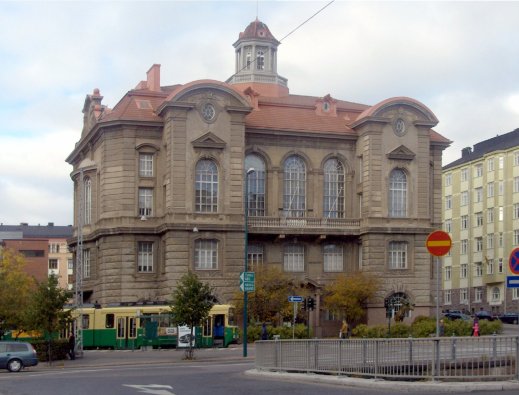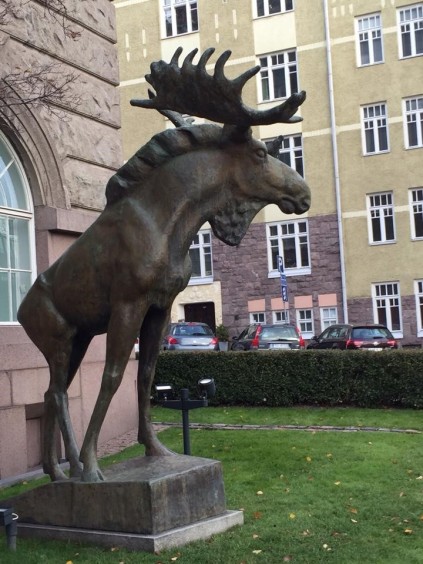
The Natural History Museum of Helsinki, located in the centre of the city, is an integral part of Finnish history in both terms of the building itself and the collections that can be found within. The building was established in 1913, making it older than an independent Finland, which separated from Soviet Russia in 1917. The current displays of the museum include skeletons, taxidermied animals, and remains of prehistoric animals and minerals. These exhibitions are divided, where the first floor is dedicated to the showing of bones, leaving the upper floors available to display nature with a strong focus on those residing in Finland and surrounding areas. This focus on local specimens highlights how this museum reflects and instils a sense of Finnish identity of the people. This reflection of identity is not only found in the collections and exhibitions, but also the evolution of the building itself.
The building was originally established as a gymnasium for a Russian school for boys, which only lasted for six years. After Finland gained its independence, the building was reinstated as a cadet school in 1919 once all of the imperial emblems dedicating the building to the late Russian tsar Alexander II had been removed. The buildings time as a cadet school was also short lived, only lasting a few years. The cadet school was moved to a town called Munkkiniemi, located outside of the city. The building was then bought by the University of Helsinki in 1923, and by 1925 it was opened as the ‘Eläinmuseo’ (Zoological Museum). The university was in dire need of the extra space, as its Zoological department and natural collections had been crammed into various locations.
The Zoological Museum then spent the following decades expanding its collections through donations, purchases and hunting and collection expeditions. The main function of the museum in the early days of its opening was to facilitate the researchers and students of the university. This was reflected in the opening times for the public, which were restricted to four hours on Sundays. Later in the 1920’s this changed as the space grew in importance for public education. The taxidermist at the time, Jussi Mäntynen, began to import new ways of displaying animals, inspired by techniques developed by the American Carl Akeley. Simple taxidermic displays transformed into vivid scenes of animals in their natural environment, and scientific jargon was replaced by life-history descriptions. Eventually the name ‘Zoological Museum’ became misleading, as the collections diversified in nature, and in 1996 it was renamed ‘Luonnontieteellinen museo’.
The zoological collection currently housed in the museum includes over 9 million specimens, most of them insects. Furthermore, the vertebrae collection makes up 140,000 of that total. These vertebrae are shown in a variety of different ways, where reptiles, amphibians and fish are usually preserved in alcohol, while the birds and mammals are displayed with their skins, skeletons, or through taxidermy. The majority of these vertebrae samples are native to Finland and the surrounding areas, where they are used both for research purposes and for public exhibition.
The collections that are displayed at The Natural History Museum have a strong focus on taxidermy, where a lot of the iconic pieces can be traced back to the works of the first two taxidermists whose work feature in the museum. Magnus von Wright and Jussi Mäntynen are of particular significance not only because their work can be found at The Natural History Museum, but also because of their cultural significance, as they are more renowned for their art than their taxidermy. Magnus von Wright was the first to publish a guidebook on Finnish birdlife, and his taxidermied vertebrae are amongst the oldest in the museum, dating from the 1820’s. Jussi Mäntynen imported new methods of taxidermy to Finland, aiming for accurate details within the animals. To this day his works are present in the museum, including his bronze statue of a moose outside the museum. His artistic sculptures can also be found across Europe and the US.

The museum has also been part of Global Plants Initiative (GPI), a database used by researchers and students worldwide, since 2009. The aim of this organisation is to make available a range of different plants, fungi, and algae through digital images of different herbaria (collection of preserved plant samples). The GPI allows the continued research and teaching of fields including ecology, botany and conservation. So far, the digitised herbaria of The Natural History Museum include lichens and vascular plant collections. This programme allows for some of the collections at the museum to be viewed by researchers from around the globe, making it a fundamental tool for supporting research in the fields of ecology, botany and conservation.
When all is considered about the current displays found within the Natural History Museum, it can be seen that it contains critical information regarding the nature that surrounds Finland. Their collection has allowed them to serve in the research and teaching in the fields of geology and biology, with a preference for those surrounding the local areas, which is demonstrated within the collections of the museum.
The importance of the museum derives not only from its role in education and research, but also from its cultural significance. The taxidermied animals reflect the works of significant Finnish artists such as Magnus von Wright and Jussi Mäntynen. However, it’s not only the displays and pieces that are of importance to the people, as by looking at the development of the building itself, it becomes obvious that this is a site that contains and reflects a sense of national identity of the Finnish people. Its existence spans for the entirety of a Finland under its own authority, and its history is deeply rooted in modern ideals, in terms not only relating to its brief period as a cadet school, but also its time spent in the research and education of its people as a museum.
Further Information:
Address: Luonnontieteellinen museo, Pohjoinen Rautatiekatu 13, 00100 Helsinki, Finland
Main website: https://www.luomus.fi/en